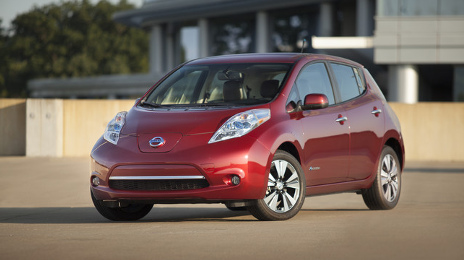Don’t expect to see a huge residual value impact from the decision to transition Scion to the Toyota brand.
According to Eric Ibara, Kelley Blue Book’s director of residual values, Scion vehicles tend to hold their value better than others.
But the challenge was from increased preference of utility vehicles over cars — something that a brand transition isn’t necessarily going to change.
“While this is a major change for Scion and its dealers, the impact on residual values for Scion vehicles is likely to be mild. Scion’s vehicles retain their value better than average, and some of their vehicles, like the now discontinued xB, were in contention for Kelley Blue Book’s Best Resale Value Awards,” Ibara said in an analysis sent to the media.
“The headwinds affecting Scion are the consumer trend favoring utility vehicles over cars, which is not solved by a Toyota badge,” he added. “To the extent that more Toyota dealers are energized to bid for these vehicles at auction, we may see slightly higher residual values; but at this point, that is somewhat speculative.”
According to a sales history of Scion provided in a Toyota news release, annual new-car sales for the brand peaked in 2006 at 173,034. Much of the years since then, however, have shown declining numbers.
There were 56,167 new Scions sold last year.
“The Scion brand never quite caught on in the way that Toyota hoped it would. By offering Scion products under the Toyota badge, the company can save marketing costs and eliminate what had effectively become a distraction from its core business focus,” Edmunds.com senior analyst Jessica Caldwell said in commentary provided to the media.
“Why didn't Scion catch on? For one thing, it's hard being a small car brand when shoppers opt for SUVs and trucks whenever gas prices aren't sky high. Last month, 58 percent of US sales were light trucks. Showroom traffic suffers when a brand doesn't offer such a popular segment of vehicles,” she added.
In a news release on Wednesday, Toyota said “customers’ needs” drove the decision to transition the Scion brand.
“Today’s younger buyers still want fun-to-drive vehicles that look good, but they are also more practical,” the company said. “They, like their parents, have come to appreciate the Toyota brand and its traditional attributes of quality, dependability and reliability. At the same time, new Toyota vehicles have evolved to feature the dynamic styling and handling young people desire.”
The car whose late-model auction values showed the most positive change during the fourth quarter?
According to a Kelley Blue Book analysis, it was an electric vehicle: the Nissan LEAF.
This took place, even amid gas prices that tumbled more than 14 percent.
Specifically, KBB Auction Values on model-years 2012 through 2014 LEAF vehicles were up 3 percent in Q4 from where they were in the third quarter.
Average gas prices fell $0.32 in Q4, a decline of 14.2 percent, KBB reported.
“Despite the continued drop in fuel prices, the Nissan LEAF was the best performing vehicle across all segments, appreciating 3 percent, or roughly $300,” KBB analyst Sean Foyil said in the latest Blue Book Market Report.
“This rebound could be attributed to consumers now finding the current value of electric vehicles more attractive at their current price point following months of steady declines,” Foyil said.
After the LEAF was the Ford Taurus, whose values were up 0.8 percent in Q4, followed by three models that trended flatly (Chevrolet Tahoe, Ford E350 Super Duty Cargo, Honda CR-Z).
Gas prices continue to plunge, and this trend is in part driving sustained wholesale price strength for trucks. The truck segments — pickups, in particular — performed extremely well as far as retention goes in the lanes last year, and the same trend is showing up in 2016.
According to the latest Black Book Market Insights report, this past week trucks saw a “strong period” of retention, while cars put in a weaker performance.
“Trucks experienced the smallest week-over-week depreciation seen this year,” Anil Goyal, vice president of automotive valuation and analytics, said in the report.
Specifically, trucks saw prices fall by 0.28 percent or $42 last week, while cars took a hit of 0.37 percent or $38.
The car segment decline was significantly higher than the same week last year, when cars dropped by just 0.21 percent at auction.
Two weeks ago, the midsize car segment was the first of 2016 to see a spike in value, but this past week, all car segments experienced downward pressure.
The car segment that experienced the largest price drop last week was the prestige luxury car segment with a drop of 0.65 percent or $197, followed by the near luxury car segment with a drop of 0.59 percent or $92.
The best performing segment among the cars last week was sporty cars, which dropped by 0.30 percent or $21.
The price change at auction for trucks last week was more in line with year-over-year trends; during the same week of 2015, trucks fell by a rate of 0.25 percent.
The full-size pickup segment performed well throughout 2015, and this past week was no different. In fact, the full-size pickups’ depreciation of just 0.02 percent was the best performance the segment has seen since September of last year.
Auction sentiment in the lanes could give some insight into why prices remain strong among pickups — on top of low gas prices, there might be a supply issue, as well.
Black Book editors overheard a buyer from Tennessee state, “Good selection of cars here today, but not a lot of pickups.”
On the other end of the spectrum, the compact van segment was out in front in terms of depreciation impact for the truck segments, with a price drop of 1.93 percent or $191.
Though many expect used prices to drop as off-lease supply expands in the auctions lanes this year, used-car prices were still on the way up in December.
The most recent Market Update from RVI Group shows that the company’s Used Vehicle Price Index jumped up by 0.7 percent in December when compared to November prices. That said, year-over-year, the index was down by 3.2 percent.
This used market movement occurred while new-vehicle prices fell by just 0.1 percent in December on a monthly basis.
RVI reported there were some small changes in residual values in December, but nothing too significant.
The midsize sedans and SUVs saw the biggest jump in residuals in December. The midsize sedans saw residuals spike by 2 percent from November, while the mid-size SUVs were up by 1.7 percent.
Luxury coupes and full-size sedans took the biggest hits in terms of residuals during the last month of the year. Luxury coupe residuals dropped by 2.2 percent from November, while full-size sedans declined by 1.5 percent.
Lastly, when looking at predictions for future residuals, keep in mind the dropping price of oil. Gas prices dropped in December to an average of $2.14 a gallon, according to the report, which was down 5 percent from November and down 19 percent year-over-year.
Depreciation in the lanes is slowing down as tax season gets underway.
Last week, car prices dropped by an average of 0.29 percent or $30 in the auction lanes, while trucks dropped by a larger 0.39 percent or $59.
That’s according to the latest Black Book Market Insights report that highlighted the slowdown in price declines.
“Overall weekly depreciation rates decreased as some segments start to show strength prior to the tax-season. We expect depreciation to remain low through tax season,” said Anil Goyal, vice president of automotive valuation and analytics at Black Book.
Sentiment in the auction lanes echo this assertion. Black Book editors overheard one buyer from Massachusetts noted, “January is off to a good start in this market area,” while another auction attendee from Connecticut said, “Prices were strong this week compared to the last two.”
The decrease among the car segments last week was a bit slighter than the 0.33-percent drop experienced during the same week of 2014.
The midsize car segment, Black Book editors pointed out, is the first of 2016 to see a rise in value. This segment saw prices rise by a slight 0.02 percent or $2.
Compact and full-size cars, on the other hand, saw prices drop the most out of any segments, with rates decreasing by 0.54 percent and 0.56 percent, respectively.
For the trucks, this past week’s drop of 0.39 percent is significantly higher than the 0.17-percent decline seen in during the same week of 2014. That said, this movement is most likely a market correction as truck prices soared in 2015.
The subcompact (no change), compact (down 0.25 percent or $29) and mid-size CUV/SUV (down 0.25 percent or $36) saw the strongest price retention last week among the trucks.
All luxury CUV/SUV segments took a hit last week, depreciating by over half a percent last week.
Prices for pickup trucks held strong throughout most of 2015, touting retention rates much stronger than their smaller counterparts. But that trend is shifting.
As 2016 gets underway, trucks are feeling the impact of heavier-than-normal depreciation trends, while cars are continuing on a downward path, as well, when it comes to prices in the lanes.
That’s according to the latest Black Book Market Insights report, which showed trucks depreciated at an average rate of 0.69 percent or $104 last week, while car prices dropped by 0.45 percent or $46.
“After a very strong showing last year, pickup truck values declined at a higher pace than the rest of the market. Car segments continue to show a steady depreciation trend,” said Anil Goyal, vice president of automotive valuation and analytics for Black Book.
The large drop for trucks was significantly higher than the average rate of depreciation of 0.47 percent seen during the past two months, Black Book pointed out.
Interestingly, although pickup trucks are coming off a strong year in 2015, this group saw some of the most dramatic depreciation in the lanes last week.
Truck segments showing the highest declines in price last week include the full-size pickup, compact van and small pickup segments, dropping by 0.99 percent, 0.89 percent and 0.85 percent, respectively.
The subcompact luxury SUV segment saw the best performance among the trucks with rates remaining mostly steady from the prior week’s performance.
The 0.45-percent drop seen among the car segments is close to the average depreciation rate of 0.49 percent seen over the previous eight weeks.
The car segments that took the biggest hit last week were the prestige luxury, sporty car and subcompact car segments, which dropped by 0.80 percent, 0.61 percent, and 0.61 percent, respectively.
The new luxury segments continued to outperform the market average with a slight drop of 0.17 percent or $69.
As for the sentiment in the auction lanes before the tax season surge begins and wholesale demand spikes, Black Book reported, “Many dealers feel auction activity has remained light heading into late January, which could spell an interesting spring season.”
Though wholesale prices were on the way down as 2015 came to a close, there are a few factors that held rates in the lanes up last year, even as used supply began to grow.
According to ADESA Analytical Services, wholesale prices in December averaged $9,763, down 1.2 percent compared to November. December’s average represented a 1-percent drop year-over-year.
And though prices are falling at auction in light of used supply, ADESA’s Tom Kontos shared in the latest edition of Kontos Kommentary how a group of factors combined to keep used prices relatively strong.
“2015 was largely a year when strong retail used-vehicle and CPO demand, benign new-vehicle incentive activity, and the embrace of upstream as well as traditional auction processes among remarketers diluted the usual negative impact of growing supply on wholesale values,” said Kontos. “Further masking that impact was the displacement of off-rental program vehicle volume that appeared in the first half of the year rather than the last quarter of 2014.”
Kontos said these off-rental vehicles are often high-dollar, late-model units, which served to push average wholesale prices upward for much of the year.
“Nevertheless, supply growth underlies the wholesale price softness seen later in the year and most evidently in December, as prices fell by upwards of one percent on both a month-over-month and year-over-year basis,” he said.
On a segment level, minivans were the only segment to see significant prices increase in December, while overall, priced in the truck segments saw stronger price retention than cars and crossovers last month.
Wholesale transaction price movement varied by group. First up, wholesale prices for vehicles remarketed by manufacturers were up 1.6 percent from November, but down 3.5 percent year-over-year. Next up, prices for fleet/lease consignors were down by just 0.1 percent from November and down 0.7 percent annually.
“Within that category, off-rental risk units had modest month-over-month and year-over-year price increases, while prices for three-model-year-old vehicles, a proxy for off-lease vehicles, were down significantly both month-over-month and year-over-year,” Kontos said.
Lastly, dealer consignors saw a 2-percent drop in price versus November and a 1.2-percent decline year-over-year.
To view the latest Kontos Kommentary video, see above.
The wholesale market closed the year out on a slow note with market activity down and auction prices falling.
According to the latest Guidelines report from NADA Used Car Guide, prices of used vehicles up to 8 years old fell by almost 2 percent in December.
This decline was much larger than the 0.5-percent decline averaged over the past five years during the same period, and marked the weakest result for the month since 2003, NADA Used Car Guide reported.
Consequently, the NADA Used Car Guide seasonally adjusted used-vehicle price index dropped by 1.6 percent from November to 122.4, which was down almost 2 percent from December 2014’s levels.
And although December’s prices weakened, the report stated 2015 was one of the strongest years on record for used-car prices from a big-picture perspective.
“In index terms, used-vehicle prices slipped by just 0.3 percent from the all-time high averaged in 2014, and while depreciation increased from 12.7 percent to 14 percent, the rate of decline remained moderate by historical standards,” NADA Used Car Guide’s Jonathan Banks said in the report.
Looking forward to the first quarter, of course, most everyone in the auto retail business is getting ready for tax season.
And although used-vehicle prices are once again expected to improve over the first quarter before dropping as we head into summer, the jump might not be quite as big as usual.
“Coinciding with the steady receipt of tax refund checks, used vehicle prices gradually improve over a given first quarter before tapering off as spring progresses,” Banks said. “While we expect a similar pattern to play out over the next few months, we believe higher supply will dampen this year’s Q1 rise.”
NADA UCG expects the December-to-January price change to range from flat to a 0.5-percent increase. Then, prices are predicted to jump by about 1 percent per month in February and March.
January’s results will probably stay in line with similar seasonal trends seen before for the month, but February and March might be a bit unusual.
Banks explained that the 1.5-percent to 2-percent increase in prices expected by the end of the quarter is much less than the 5 percent average over 2010-2015. Last year, prices were up by 4 percent from December to March.
Taking a look at segment movement, the prices of large SUVs, large pickups, midsize vans and mid-size pickups are expected to increase by more than 2 percent by the end of March.
On the other hand, prices of subcompact cars, compact cars and luxury large cars should stay pretty steady with December levels.
The news will come as no surprise to industry veterans, but market activity in the lanes last week began to slow, as is often seen at the turn of a new year.
According to the latest Black Book Market Insights report, last week brought with it continued higher depreciation for smaller cars.
But after a slow period to start of 2016, Black Book expects “a robust spring buying season” due in part to heavy depreciation experienced during the fourth quarter that have made vehicles more affordable for dealers.
“Values continued their decline in the new year with higher depreciation in small cars. We are anticipating strong buying in the tax season this year after the sharp decline of car values in the fourth quarter last year,” Anil Goyal, vice president of automotive valuation and analytics at Black Book, said in the report.
Overall, car prices fell by 0.65 percent or $67, while trucks dropped off by .060 percent or $90. For both cars and trucks, these numbers were higher than the average depreciation rate seen over the previous eight weeks: 0.50 percent for cars and 0.44 percent for trucks.
Among the cars, the categories to see the biggest declines in the lanes last week were the compact (down by 1.22 percent or $15), subcompact (down by 0.96 percent or $89) and the prestige luxury (0.96 percent or $56) segments.
The best performing car segment was the midsize car category, which only saw a drop of 0.39 percent or $17 last week.
On the truck side of the market, the subcompact luxury CUV (down 1.58 percent or $151), minivan (down 1.17 percent or $91) and compact van (down 0.90 percent or $3) segments took the biggest percentage hits.
The full-size crossover/SUV segment had a good week with rates only falling by 0.10 percent, and the full-size van segment only dropped by 0.03 percent.
The battle between supply and demand is nothing new to dealers — and as we head further into the forecasted growth in used-vehicle supply, wholesale price softening is to be expected.
The latter is the message from ADESA Analytical Services’ executive vice president and chief economist Tom Kontos in the December edition of Kontos Kommentary, where he summed up the year quite succinctly and set the scene for 2016.
“2015 was largely a year when strong retail used vehicle and CPO demand, benign new-vehicle incentive activity, and the embrace of upstream as well as traditional auction processes among remarketers diluted the usual negative impact of growing supply on wholesale values,” Kontos said in the report.
“Further masking that impact was the displacement of off-rental program vehicle volume that appeared in the first half of the year rather than the last quarter of 2014,” he added. “These high-dollar, late-model units biased average wholesale prices upward for much of the year.”
Unfortunately, that dilution of wholesale values started to clear up by the end of the year, most notably in December, where Kontos says prices fell by upwards of 1 percent on both a month-over-month and year-over-year basis for various segments.
Let’s break it down. Wholesale used-vehicle prices in December averaged in at $9,763, a decrease of 1.2 percent month-over-month and down 1.0 percent relative to December 2014.
The only vehicle segment that showed any significant monthly increase was the minivan segment, while truck values, in general, declined less than cars and crossovers.
Looking at the various types of sellers, wholesale prices for vehicles remarketed by manufacturers were up 1.6 percent month-over-month but down 3.5 percent year-over-year. For fleet/lease consignors, both metrics were down 0.1 percent and 0.7 percent, respectively.
Within the fleet/lease consignment category, off-rental risk units showed small month-over-month and year-over-year price increases.
Three-year-old vehicles, however, did not, Kontos said. These vehicles — which he said are a “proxy for off-lease vehicles” — showed significant declines in both pricing metrics.
Dealer consignment saw a 2-percent decrease in December, compared to November, and a 1.2-percent decreased compared to December 2014.
To check out Kontos’ full breakdown of wholesale used-vehicle prices by vehicle model class, click here.












